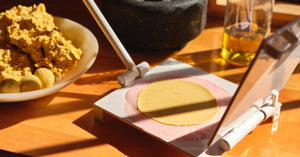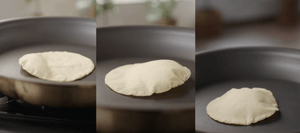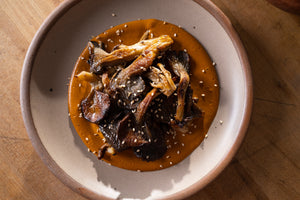Masa Feature : Blue Chalqueño (Oaxaca)
Masa Feature : Blue Chalqueño (Oaxaca)

April 12, 2020
We're thrilled to (finally!) be kicking off a new series at Masienda called Masa Feature, where we take a featured varietal all the way from kernel to masa (and beyond) and share our cooking, aesthetic and tasting notes with you to reference at home. We hope that Masa Feature is as much about sharing with you as it is about you sharing your own observations with us and the greater masa community. To this end, we encourage you to ask questions and respectfully comment throughout the experience. Veer off course and happen upon a totally new way of grinding effectively at home? Have a request for something you'd like us to test out at Masienda HQ? Let us know!
This month is all about Blue Chalqueño from Oaxaca's central valley, specifically Etla, brought to us by growers Don Demetrio and Rigoberto. In addition to being a fun new micro-lot for us--only 4,000 lbs from 2019/2020 harvest--we chose this varietal because it showcases some of the nuance that you can often see geographically within the same landrace. To date, we have sourced blue chalqueño from Estado de México, for example, which is quite different texturally--being a softer, lighter, more tender starch and almost double the kernel size. This varietal of chalqueño, by contrast, strikes a great balance between hard and soft endosperm, giving its resulting tortillas a hearty but supple structure.
Our preparation notes, from kernel to finished tortilla, are below, with hyperlinks to each chapter of our Kernel-to-Masa series on Masienda's YouTube channel, making it easy to follow along with our go-to instructions for preparing any varietal. As we did on the nixtamalization portion of this month's preparation, we'll continue to take some liberties on some of the steps, in order to try new things and provide additional reference points for anyone following along at home.
Pre-Cook:
We were going for a finished table tortilla masa--that's to say, a fine grind for a tortilla that puffs. Also, craving the tlacoyos that we'll always stop for at the roadside cabañas outside La Marquesa on the way to the home of Don Armando (of blue cónico fame), we planned to use about half of the masa for black bean tlacoyos (not pictured...next time though).
(Thursday 4/9/2020, 5 pm ish) We started with 5 lb. of corn and .8 oz. of cal (translating to exactly 1% cal to corn weight). In instances of cooking blue or red varietals, we'll sometimes err on a slightly lower cal ratio, say 0.8%, to really let the color come through, but 1% still allowed for a clean finish in this case.
I tend to shy away from recording cook times because of how wildly different everyone's heat sources look from one another. We used a pretty basic induction burner, for example, which is going to function differently from a gas stove, professional range, electric stove or even other induction burners, for that matter. Instead, I brought the corn and water (with cal already added) up to a boil and turned down to med-high heat. From there, I'd check every 5 minutes or so on the skins and the flavor. Again, I did not record times, but if I had to guess, the skins started to come off easily after about 10 minutes and the flavor was fully bloomed with the right al dente texture at about 17/20 minutes into the simmer. No ice was used to shock the water. Instead, we covered the pot after turning off the heat, in order to let the residual heat continue to cook the corn a bit more (since we ended on the more al dente side).
Nixtamalization:
Friday got busy, and it wasn't until the late afternoon that we were able to get around to rinsing the nixtamal. In total, the corn spent about 22 hours nixtamalizing. Because we allowed for some additional residual cooking, our nixtamal still had a nice bite to it and hadn't taken on excess water or cal.
Nixtamal Rinse:
This being a new lot of chalqueño that we hadn't worked with before, we wanted to get as clear a picture of the pigmentation as possible, so we did almost 100% wash off of the skins. As you can see, there is practically no yellow pericarp visible whatsoever.
Nixtamal Grind:
Not gonna lie, here. We were recalibrating our office Molinito on this run and ended up with an ever-so-slightly-coarser grind on this masa. Still fine enough for a table tortilla puff, but there were definitely very fine particles perceptible on this grind. I actually love the result, from an aesthetics perspective, because the darker, harder endosperm bits contrast beautifully with the lighter, mixed masa color. All in all, a nice marbling effect and workable grind that I was grateful to not do by hand! Because we'd rinsed off almost all of the skins, the grind was especially fast (I'll have to time it next time, in case you're hoping for specifics).
Masa Mixing:
Normally, we'd have one of two KitchenAid mixers in house for this step: mine or our COO, Danielle's. Like so many of us living in quarantine, however, we've both been baking more at home, in addition to mixing our Authentic Mexican Masa Harina for our daily dose of tortillas. That's to say, no KitchenAids in the office on this run, so I improvised with my hands. Manual mixing works, but I generally trust the KitchenAid more than myself to blend everything as evenly as possible. I added about 4 or 5 oz of water to the masa, which, because it has a harder, denser starch compared to its Estado de México counterpart, needed a bit more hydration to perk up for the table tortilla cook. No salt or coloring was added to the masa.
Masa Press and Tortilla Cook:
Used our Doña Rosa x Masienda tortilla press with some pre-COVID plastic grocery bag cutouts that we save for pressing. On the first press or two, I noticed that there was no steam coming off the top of the tortilla, which was an indication that it needed some more moisture. I added a bit more water to the masa, and by the third tortilla, we were in business. As in our video, we used an electric griddle, which can only get up to about 400-425 degrees F. This means that the puff is not quite as dramatic as you might expect from a ripping-hot comal or conveyor oven, but we still got enough puff to cook through the center.
Tasting notes: We weren't planning to use these for tacos, rather to enjoy them a la minute as a nice pre-dinner snack, so I took them a little farther on the griddle for a slight amount of char with a still-molten center. Notes of roasted almond butter, hay and black dirt all came to mind as we enjoyed them with and without salt.
Some things that occur to us might be helpful for future features:
- Finished yield (corn to masa)
- Cook time (notwithstanding differences in our induction burner from everyone's unique heat source at home)
Anything else?
Stay safe and be well, in the meantime.
-Jorge


